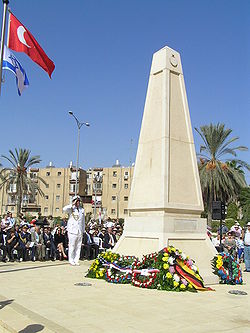The Battle of Beersheba (Turkish: Birüssebi Muharebesi, German: Schlacht von Birüssebi) was fought on 31 October 1917, when the British Empire's Egyptian Expeditionary Force (EEF) attacked and captured the Yildirim Army Group garrison at Beersheba, beginning the Southern Palestine Offensive of the Sinai and Palestine campaign of World War I. Infantry from the 60th (London) and the 74th (Yeomanry) Divisions of the XX Corps from the southwest conducted limited attacks in the morning, then the Anzac Mounted Division (Desert Mounted Corps) launched a series of attacks against the strong defences which dominated the eastern side of Beersheba, resulting in their capture during the late afternoon. Shortly afterwards, the Australian Mounted Division's 4th and 12th Light Horse Regiments (4th Light Horse Brigade) conducted a mounted infantry charge with bayonets in their hands, their only weapon for mounted attack, as their rifles were slung across their backs. Part of the two regiments dismounted to attack entrenchments on Tel es Saba defending Beersheba while the remainder of the light horsemen continued their charge into the town, capturing the place and part of the garrison as it was withdrawing.
German General Friedrich Freiherr Kress von Kressenstein was commander of the three divisions of the Fourth Army. He further strengthened his defensive line stretching from Gaza to Beersheba after the EEF defeats at the first and second battles of Gaza in March and April 1917, and received reinforcements of two divisions. Meanwhile, Lieutenant General Philip Chetwode (commanding the EEF's Eastern Force) began the Stalemate in Southern Palestine, defending essentially the same entrenched lines held at the end of the second battle. He initiated regular mounted reconnaissance into the open eastern flank of the Gaza to Beersheba line towards Beersheba. In June, the Ottoman Fourth Army was reorganized when the new Yildirim Army Group was established, commanded by German General Erich von Falkenhayn. At about the same time, British General Edmund Allenby replaced General Archibald Murray as commander of the EEF. Allenby reorganized the EEF to give him direct command of three corps, in the process deactivating Chetwode's Eastern Force and placing him in command of one of the two infantry corps. At the same time, Chauvel's Desert Column was renamed the Desert Mounted Corps. The stalemate continued through the summer in difficult conditions on the northern edge of the Negev Desert, while EEF reinforcements began to strengthen the divisions which had suffered more than 10,000 casualties during the two battles for Gaza.
The primary functions of the EEF and the Ottoman Army during this time were to man the front lines and patrol the open eastern flank, although both sides conducted training of all units. The XXI Corps maintained the defences in the Gaza sector of the line by mid-October, while the battle of Passchendaele continued on the Western Front. Meanwhile, Allenby was preparing for the manoeuvre warfare attacks on the Ottoman defensive line, beginning with Beersheba, and for the subsequent advance to Jerusalem, and he was nearing completion with the arrival of the last reinforcements.
Beersheba was defended by lines of trenches supported by isolated redoubts on earthworks and hills, which covered all approaches to the town. The Ottoman garrison was eventually encircled by the two infantry and two mounted divisions, as they and their supporting artillery launched their attacks. The 60th (London) Division's preliminary attack and capture of the redoubt on Hill 1070 led to the bombardment of the main Ottoman trench line. Then a joint attack by the 60th (London) and 74th (Yeomanry) Divisions captured all their objectives. Meanwhile, the Anzac Mounted Division cut the road to the northeast of Beersheba, from Beersheba to Hebron and continuing to Jerusalem. Continuous fighting against the main redoubt and defenses on Tel el Saba which dominated the eastern approaches to the town resulted in its capture in the afternoon.
During this fighting, the 3rd Light Horse Brigade had been sent to reinforce the Anzac Mounted Division, while the 5th Mounted Brigade remained in corps reserve armed with swords. With all brigades of both mounted divisions already committed to the battle, the only brigade available was the 4th Light Horse Brigade, which was ordered to capture Beersheba. These swordless mounted infantrymen galloped over the plain, riding towards the town and a redoubt supported by entrenchments on a mound of Tel es Saba south-east of Beersheba. The 4th Light Horse Regiment on the right jumped trenches before turning to make a dismounted attack on the Ottoman infantry in the trenches, gun pits, and redoubts. Most of the 12th Light Horse Regiment on the left rode on across the face of the main redoubt to find a gap in the Ottoman defenses, crossing the railway line into Beersheba to complete the first step of an offensive which culminated in the EEF's capturing Jerusalem six weeks later.









